Tiger Den Basketball Archives –VI
First Visit to the Big Apple
Harry Rabenhorst's LSU cagers traveled to New York City to play in a twinbill at Madison Square Garden Thursday, December 19, 1946.
- The opponent was tiny St. Francis College, an unknown basketball team from Brooklyn. A week earlier, the Terriers gave mighty NYU all they could handle before bowing 50-42 before 18,000 in a doubleheader at the most famous arena in the world. The defeat was the only one in four outings.
- The Catholic school fielded a veteran team with plenty of hustle to make up for their lack of height. The tallest player was 6'4" John Zeitler who scored most of his points on set shots.
- Coming off an 18-3 season in 1945-46, when the Tigers lost to Kentucky in the finals of the SEC Tournament to miss a chance at their first appearance in the NCAA Tournament, LSU started the 1946-47 season 2-0 with home wins over Keesler Field 81-48 and the defending Southwest Conference champions from Baylor 61-34.
- With nine letter winners returning, the Tigers fielded a tall lineup that average 6'3". Two of the leading scorers from '45-'46 returned in the persons of Bobby Lowther and 6'4" Joe Bill Adcock. Rabenhorst also enjoyed the services of Frank Brian, a sophomore who returned from three years in the army.
- The contest would precede the nightcap between City College of New York and Bowling Green.
New York Times Picture
SOUTHERN QUINTET HERE TO MEET ST. FRANCIS ON GARDEN COURT TONIGHT

L-R: Bobby Lowther, Charlie Webb, Joe Adcock, Bill Walters, Frank Brian

Bill Walters
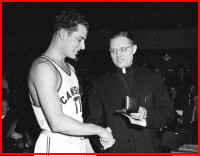
Leroy Chollet, Canisius
|
More than 17,000 fans saw an exciting contest in which the Tigers come from behind four times.
- Whether it was travel weariness, stage fright, or the skill of the opponent, LSU fell behind by 12 points, 30-18, four minutes before halftime. Led by Brian, the Tigers narrowed the margin to 32-23 by halftime.
- With veterans Adcock in the pivot and Bill Walters outside dropping in points, LSU finally pulled ahead for the first time, 45-44, 12 minutes into the second half.
- The game see-sawed back and forth for the next five minutes before Walters canned a long set shot to put the Southerners ahead for good.
- Brian, who led all scorers with 15, ended the Terriers' hopes with a layup in the closing seconds to make the final score 62-57.
- Adcock and Walters tallied 12 each, and Lowther contributed 11 more.
Two nights later, the Tigers took on Canisius, another Catholic college, as part of a doubleheader in Buffalo NY.
- The star of the Canisius team was a New Orleanian, Leroy Chollet, a graduate of Holy Cross High School.
- Leroy had been the leading scorer on Loyola of New Orleans' National Association of Intercollegiate Basketball national champions in 1944- 45.
- Loyola stated that Leroy transferred to Canisius, another Jesuit college, because of academic difficulties. Years later, Leroy told his son that he had to leave Loyola because he cheated on an English paper.
- However, Chollet had a secret that may provide the real explanation - he was one-eighth black.
- Perhaps because his younger brother Hillary, a football star, was the object of a recruiting battle between LSU and Tulane, someone uncovered the Chollet secret, and word spread like wildfire throughout segregated New Orleans.
|
On Saturday, December 12, 1953, the Kansas Jayhawks came to Baton Rouge for the first time ever.
- Led by senior C Bob Pettit, the Tigers easily won their first two games over Pensacola Navy (109-68) and Louisiana College (128-74).
- As a result, LSU vaulted to #10 in the AP poll, five spots behind their guests from Kansas.
- Regardless of what happened in Baton Rouge, the Jayhawks would drop in the poll thanks to a 69-65 loss at Tulane in their season opener Thursday night.
Fans licked their chops in anticipation of the duel between Pettit and KU's C B. H. Born, also 6'9".
- Bob had just popped in 60 points after a mere 32 against Pensacola to regain the all-time SEC scoring record.
- Pettit usuallly didn't score that many, content to rebound and pass.
- Born averaged 18.7 ppg in the 1952-53 campaign with a single game high of 44 against Colorado for an all-time Big Seven Conference record. He was considered an artist in faking as well as a superb defensive player. In less than three minutes, he succeeded in getting the Greenies' big C, Jim Nowakowski, to commit three fouls.
- Observers of the KU-TU game agreed that the visiting squad wasn't in peak physical condition and tired noticeably in the late going. Born slowed down to a walk midway through both halves and had to be spelled several times. Still, he emerged as the top scorer with 28.
Kansas's 67-year-old coach Phog Allen, who learned the game directly from its inventor, James Naismith, praised Pettit to the hilt.
There is a boy who is a credit to the game of basketball. Not only is he a marvelous player, which in itself is a credit to the Tigers, but being a home town product makes him doubly so. We need more boys like him to create interest in the hardwood sport.
When you have a boy of his ability and height, you can build your entire offense around him and have a winner ...
I saw the Tigers in the national tournament this year, and Harry Rabenhorst has one of the top teams in the nation.
I'm not saying that I expect to win out over Rabby's boys, for it will be our second contest of the season, and we need a lot of work. That's why we're down here. We want tough competition and, although we hate to lose, we want to be ready for conference opponents.
Tulane coach Cliff Wells, who considered the victory over Kansas one of the greatest accomplishments of his lifetime of coaching, predicted an LSU victory by 15 points.
More than 11,000 fans - largest crowd ever for a deep South basketball game - saw the Tigers stage a stirring second half rally in the Parker Agricultural Center to eke out the victory.
- First half: LSU scored first on a tip-in by Pettit but Born immediately countered with a bucket of his own. Soon Kansas went ahead 4-2 and stayed in front the rest of the half. The Tigers had difficulty solving the tight KU defense which came into the back court constantly to cause wild passes.
Scoring slowed in Q2 as both teams played deliberate ball.
KU led 24-20 at the end of the first ten minutes and 34-29 at the intermission.
Pettit and Born cancelled each other out with 14 points apiece. But B. H. received able assistance from co-captain Allen Kelly, who canned most of his 10 points in the opening half.
The visitors shot an even 50%, 14-for-28, in the first 20 minutes.
- Second half: Kansas started out as if to make a rout of the game, hitting from all angles to increase their lead to 44-33 on two FGs by Born and one by Harold Patterson.
At that point, Don Sebastian, a fleet, ball-hawking 5'10" sophomore G,
came off the LSU bench to give the Jayhawks a taste of their own ball-snatching medicine. Don stole passes, broke up plays, got himself fouled when points were needed most, and, in general, ruffled the Jayhawk feathers. Rabenhorst also got fine defensive work from another sub, F Jim McNeilly.
LSU cut the lead to 49-48 on a hook shot by F Ned Clark, Pettit's teammate at Baton Rouge High. But Kelley hit a long one before LSU G Maurice Magee canned a FT and, shortly afterward, another. But Dallas Dobbs put the lead back to 3 with an easy goal from the side. McNeilly cut the margin to one when he hit a long one.
Pettit drove under for a two-pointer to put the Tigers ahead for the first time since the opening basket, 54-53. Fouled on the play, Bob added the FT to make it 55-53 heading into the final ten minutes.
The Tigers never relinquished the lead as, once again, the Kansans lagged in the second half. LSU scored the first four points of the period before Kansas started hitting again.
McNeilly dumped in a couple of clutch baskets as did Clark. That increased the lead to 67-59 with only three minutes remaining.
LSU started to freeze the ball. Although the Tigers tallied only a single point the rest of the way, KU could score only four to fall 68-63.
The battle between centers ended in a draw with each bagging 27 points.
The 1953-54 Tiger roundballers finished the regular season with a 20-2 record, good for a #7 national ranking.
- Undefeated in conference play, LSU tied Kentucky, whom they didn't play, for the SEC crown.
- The Wildcats won the playoff in Nashville 63-56.
- However, when the NCAA ruled three of his players ineligible, Coach Adolph Rupp pulled his team from the NCAA tournament.
- LSU took UK's place as the SEC representative but lost in the first round to Penn State, 78-70.
|
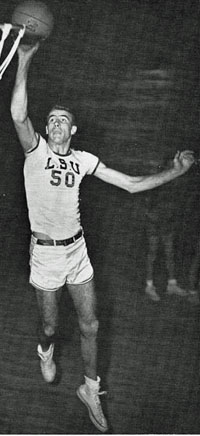
Bob Pettit
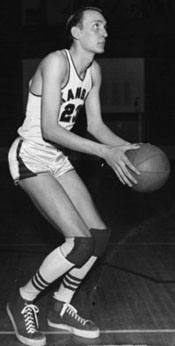
B. H. Born
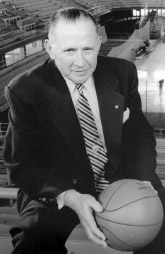
Phog Allen
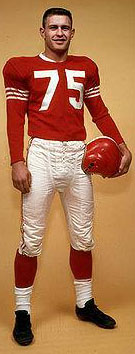
Hal Patterson, a three-sport star in KU's Hall of Fame
|
5,669 persons in Memorial Auditorium saw Chollet lead all scorers with 21 points.
- Leroy bagged 13 in the first half as the Griffins built a 30-22 halftime lead.
- But unlike the game against St. Francis, the Tigers were unable to catch their hosts, who built a 59-46 lead until Coach Earl Brown sent in the reserves with 48 seconds remaining.
- The final score was 59-50.
- Adcock topped the Tigers with 14 followed by Lowther's 13 and Brian's 12.
LSU would enjoy another strong season.
- The Tigers finished 17-4 overall.
- Two of the losses came at the hands of Tulane, one in New Orleans and one in the SEC Tournament in Louisville.
Two of the 1946-47 Tigers, Frank Brian and Joe Adcock, would have successful careers as professional athletes but in two different sports.
Brian played seven seasons in the NBA during which he netted 5,379 points.
Adcock toiled 17 years in the major leagues, most of them with the Milwaukee Braves, whom he helped to pennants in 1957 and 1958 and the World Series championship in '57. The 1B clouted 336 HRs and drove in 1,122 runs.
Leroy Chollet played two years in the NBA for the Syracuse Nationals.
References: Fight, Grin & Squarely Play the Game: The 1945 Loyola New Orleans Basketball Championship & Legacy, Ramon A. Vargas (2013)
Top of Page
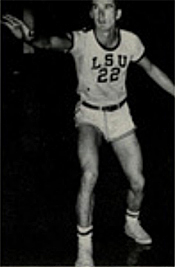
Troy Rushing
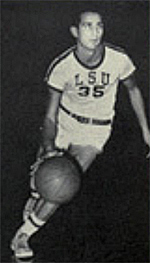
Dick Holt
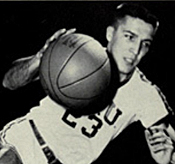
Don Sebastian
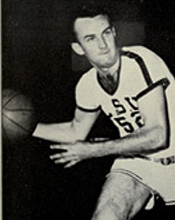
Joe Fahey
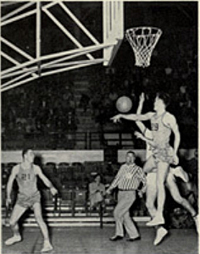
LSU-Louisiana College action 1955
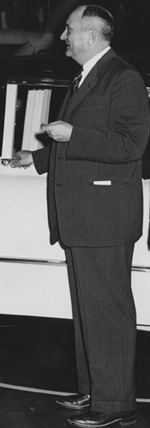
Adolph Rupp opening door to Cadillac he was awarded in 1955
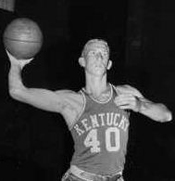
Vern Hatton
|
It's seldom you find a game in which the home team is called for 33 fouls to only nine for the visitors. But that's exactly what happened on December 1, 1955, at Parker Agricultural Coliseum.
The Times-Picayune article the day of the game began like this:
A warm-up contest Thursday night with the Louisiana College Wildcats will serve as the season basketball opener for Louisiana State's varsity Tigers, who swing right back into one of their toughies on Saturday when they collide with the Kentucky Wildcats here.
Harry Rabenhorst was beginning his 28th season as LSU coach and his second P.P. (post Pettit).
- The Tigers fell from 22-3 in '52-53 and 20-5 in '53-54, with SEC championships in both seasons, to 6-18 in '54-55.
- Harry brought in several junior college transfers to help his squad's depth behind these starters: 6'3" junior F Roger Sigler, top scorer as a sophomore the year before, 6'4" F Troy Rushing, 6'5" C Dick Holt, 5'10" G Don Sebastian, and either 6' Don Merle or 6' Joe Fahey at the other G.
- W. I. Spencer warned in his TP article: ... the scrappy Wildcats ... have won three tight games already without any losses and might even spoil the Bengals' debut. ... Thursday night's Wildcats could be almost as tough for the Tigers as Kentucky's really great Wildcats as tutored by the fabulous Adolph Rupp.
- Coach Morris Osborn's visitors featured a fast breaking offense that utilized speed rather than height. The starting lineup included three 6'2" cagers and two at 5'10". The Wildcats would test Rabenhorst's theory that he had more speed than in '54-55.

Roger Sigler and Coach Harry Rabenhorst
Not the least intimidated, Louisiana College jumped in front early 6-1.
- The Pineville Cats dominated both backboards and gained a 12-point advantage midway through the period.
- LSU managed to cut the lead to 44-36 at the halftime whistle. Neither team shot the ball well, the Wildcats going 14-of-43 (32.4%) while the Tigers hit just 14-of-49 (28.9%).
- LC built another 12-point lead in the second 20 minutes. Along the way, two Tigers fouled out, Rushing and Merle while Sigler and Sebastian racked up four fouls each.
- LSU started to hit with eight minutes left. With Roger on his way to a 36-point evening - the top output for LSU for the entire season, the Tigers cut the lead to three points, 66-63.
From then on, the game developed into a "wild brawl."
- Merle's fast break basket put the Bengals ahead 71-70 with four minutes left, their first lead since making a FT to start the contest.
- After an Wildcat FT, another of Sigler's 14 FGs pushed the margin to 73-71.
- Another Roger southpaw basket offset an LC FT to make it 75-72 LSU with 3:32 left.
- Four more of the visitors' 40 made FTs (out of an astounding 60 attempts) enabled the Wildcats to regain the lead.
- Joe Limbaugh's basket put LC up by three, 78-75, but Sigler matched it to trim the lead back to one with 1:27 on the clock.
- With no shot clock, LSU had to foul to regain possession, but Limbaugh hit both freebies, but Sigler's fielder made it a one-point game again with a minute left.
- Frank Mancil made perhaps the key play of the game when he slipped loose under the goal to lay in a FG to make the scoreboard read 82-79.
- With no three-point FG, LSU had to score twice, but the Cats rebounded the miss. G Max Smith, who led his quintet with 22 points, sank the visitors' 39th and 40th FTs with four seconds left to make the final tally 84-79.
Spencer compared Sigler favorably with LSU's greatest player to that point.
Sigler's 36 points, and he easily could have had more but for an amazing series of misses right under the basket, placed the rangy Bengal blond right up in a class with the famed Bob Pettit ... Sigler has much more speed and co-ordination than Pettit ever had, and if he develops more of the team spirit and desire to improve that Pettit always showed here, Roger has a fine chance to equal and possible eclipse some of Bob's records. Sigler's team is, at this reading, far weaker than the fairly strong Bengal squad that ranted with Pettit.
The shocking upset took some gloss off the Tigers' clash with Kentucky two nights later.
- The State-Times used this analogy. Louisiana State's basketball team will be trying to make a comeback tonight but it figures to be sort of like pulling an auto back on the road after sliding into a ditch and promptly running into a high speed freight train.
- As the back end of a home-and-home agreement Rabenhorst and Rupp arranged before the '54-55 season, the game with the #2 Wildcats would not count as an SEC contest.
- Kentucky's 74-58 victory over LSU in Lexington 12/4/54 had extended their winning streak in season openers to 29.
- One source of anxiety for the Tiger fans was the fact that they didn't control the boards against Louisiana College. So how could they compete in that department against the Lexington Wildcats, which deployed a 6'6", 6'7", 6'8" front line?
The Tigers almost did to Kentucky what Louisiana College did to them.
- LSU excited the crowd of 4,000 by leading the touted visitors most of the first half before the Cats settled down and took a 27-23 lead into the locker room.
- With Sigler held to just 11, Rushing took up the scoring slack with 17.
- Rupp's quintet led by 10 with five minutes to play, but Sigler threw in two quick FGs to cut the margin to 53-47.
- Rushing and Ken Martin hit FTs to reduce the margin to four with 3:30 on the clock.
- After the teams traded charity tosses, the Tigers lapsed into ragged play, and Vern Hatton stole the ball and sank a FG to make it 55-49.
- The final score read 62-52.
The Tigers didn't fare nearly as well when they went to Lexington January 14 and got drilled 107-65 in a conference game.
LSU finished the 1955-56 season with a 7-17 mark. Nevertheless, Sigler made all SEC. Rabenhorst would coach one more year, going 6-19 (including a hard fought 51-46 loss to UK in Baton Rouge) to retire with three straight losing seasons.
|
In 1996, Bob Pettit was voted one of the Top 50 NBA Players for the league's 50th anniversary. Yet as a sophomore in high school, Bob couldn't even make his school's junior varsity team. As he says in his autobiography, I was not born to play basketball.
Robert Pettit Jr. was the only child of the Baton Rouge sheriff and his wife.
- Little Bob loved all sports and tried to play them. But, with no older brothers to help him, he gave no indication of being a high school athlete, much less a college or pro athlete.
- He was tall for his age but thin and frail and couldn't run very fast. As a result, he was always the last boy picked in football, basketball, and baseball.
- When he entered Baton Rouge High as a freshman, he began to spring up. His ambition was to earn a high school letter in a sport.
- The 5'7" 118 lb freshman went out for football. I wasn't coordinated and I wasn't any good. But I did have desire. More than anything else, I wanted to be a good athlete. A third string tackle, he was sent in to replace the RT on defense. But he lined up as a LT instead, and the opponent went right through the opening where he was supposed to be for a 65y TD. That ended my football career.
- On the baseball team, he played 2B, but the first ball hit to him in a game went right through his legs. That ended my baseball career.
- Track? Forget it. Too slow and uncoordinated.
|
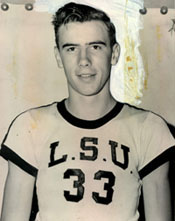
Bob Pettit
|
So Pettit decided to concentrate on basketball his sophomore year.
- Of the 17 boys who tried out for the team, Bob was one of the five cut, thus immortalizing Kenner Day as "the coach who cut Bob Pettit from his team."
- But Bob believes that, far from embarrassing Coach Day, the fact that he cut me has always indicated to me what a wise and perceptive coach he was. I didn't deserve to make the team. He knew it and truthfully, I knew it too.
- Bob was subjected to what today would be labeled bullying. One day a bunch of football players came back from practice and took three of us and shaved our heads. I tried to fight them off, but I just wasn't strong enough.
Young Bob had two choices: Give up on his ambition to be an athlete or work to improve himself.
- Bob was active in his Episcopal church where he sang in the choir, took up collections at services, and served as an altar boy.
- He and a bunch of his friends formed a three-team church basketball league. All the players were high school basketball dropouts.
- If you think the NBA is rough, you should have seen those games. This was the first organized basketball I ever played, although disorganized is a better word for it.
Bob tells this story in his 1966 autobiography: There was always this one kid on the court whenever we got there. He was a few years younger and smaller and he loved basketball more than anything else in the world. We would come along and tell him to scat and sometimes he refused and a couple of the boys would pick him up bodily and toss him off the court. I doubt if they could do that now. His name is Jimmy Taylor and he plays fullback for the Green Bay Packers.
- One of the participants in the church league was Ned Clark, who would play with Bob two years in high school and three years at LSU.
Finally getting a chance to play basketball regularly, Bob improved by leaps and bounds.
- His dad bought a backboard that he installed over the garage door.
- Bob began a routine he followed for years. He shot baskets from 3:30 when he arrived home from school to 5:30. After dinner and homework, he was out again, aided by the light from several window lamps he placed on the window sill facing the backyard.
- He also performed a daily exercise regimen: calf rises to strengthen his legs and weights to build up his arms.
- His diligence turned him into the leading scorer in the church league and a much more confident candidate for the high school team.
Bob could hardly wait for basketball season in his junior year.
- Now 6'4" and more muscular, he quickly impressed his teammates, who conducted their own practices until football season ended and Coach Day, an assistant in football, could devote his attention to basketball.
- Checking on his team, Day asked his captain who was playing center in the scrimmages. When told "Bob Pettit," Day couldn't believe it. It can't be. Last year, he wasn't good enough to stay with the jayvee.
- But when Kenner took over the team, he kept Pettit in the pivot.
- The Bulldogs captured the city championship, and Bob was named to the All-City team, which wasn't much because there were only two other high schools in Baton Rouge. But to me it was like making All-America.
- He finally won his lettered sweater. It gets pretty hot in Louisiana in May and June and I got that sweater in May and hot or not, I was going to wear it. I worked too hard for that thing to hang it in a closet.
Pettit grew a few more inches that summer and reported for his senior season at 6'7".
- BRHS started 8-3, but Bob contracted the mumps. While he was out, they lost nine games.
- When he returned, the Bulldogs won 17 in a row, culminating in the state championship over St. Aloysius of New Orleans.
Another story from Bob's autobiography: I will never forget one incident during the state tournament. It was in our first game against Fortier High. I scored only about five points in the first half and we were losing at halftime and Coach Day walked into the dressing room, picked up a towel, wet it and hit me as hard as he could across the head with the wet towel. "You get out there and show me something this half," he said. Then he walked out and went directly to my Mom and Dad, who were sitting in the stands, and told them what he did. My Dad said, "Fine."
I was so angry, I went out and scored 20 points in the second half and we won the game … I have always remembered what Coach Day did and respected him for it because I know it hurt him more than it did me.
- After averaging 19 ppg with a high of 41, Bob was invited to play in the NorthSouth All-Star High School game in Murray KY. I was very flattered to be chosen to play. He scored nine points and rebounded well. He was selected on the Chuck Taylor High School team.
1950 Baton Rouge High state champions
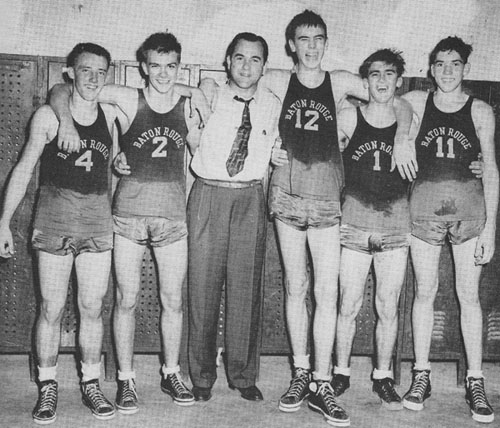
#12 is Bob Pettit; #11 is his future LSU terammate, Ned Clark. Fourteen colleges offered Pettit grant-in-aids. But there was never any doubt where he would matriculate – Louisiana State University in his hometown.
Continued below …
Reference: Bob Pettit: The Drive within Me, Bob Pettit with Bob Wolf (1966)
Top of Page

Bob Pettit |
Bob Pettit approached his college basketball career with much more confidence than he had as a high school freshman.
- Growing up in Baton Rouge, he was no stranger to the LSU campus when he arrived in September 1950.
- Not yet 18, he had reached 6'8" in height but was still gawky at 175 pounds.
- The upperclassmen on Harry Rabenhorst's team, many of whom Bob knew already or who knew him by reputation, welcomed him.
- NCAA rules made freshmen ineligible for varsity competition. So Bob played 10 games on the Baby Bengals of coach John Chaney.
- Bob assessed his game like this: I had a little jump shot and a hook shot, which I developed between my senior year in high school and my freshman year in college. I was rebounding well at both ends of the court and John Chaney showed me a move which was to help me immensely. He taught me to fake a jump shot or hook shot when I had my back to the basket, then, when the defensive man committed himself, I would drive around him for an easy layup.
- Pettit also developed a shot in which he leaned toward the basket, which put him in better position to rebound if he missed.
- He averaged 30 points a game as a freshmen, and the Tiger Frosh won 8 of 10.
- Still, Bob knew it would be a big leap to the varsity the next season. So he spent his free time during the summer practicing his shooting, especially his hook shot.
Coach Rabenhorst tailored his offense to take advantage of his front line personnel.
- The returning C from 1950-51 was 6'10" Byron Johnson. So Harry played a double post offense.
- The other big man was F Ned Clark, Bob's church league friend and Baton Rouge High teammate.
- The man running the offense was senior G Joe Dean, about whom Pettit wrote, There may have been players with more talent but I have never known a player with more confidence than Joe Dean possessed.
- The 1951-52 Tigers finished 17-7 overall, their most wins since 1947, and 9-5 in the SEC. The season ended with a one-point loss to Kentucky in the finals of the conference tournament in Louisville.
- Bob finished third in the nation with 25.5 ppg behind Clyde Lovellette of Kansas and Dick Groat of Duke.
|
The Tigers would not lose an SEC game in Pettit's remaining two years at LSU.
- The NCAA and SEC shocked the world of college basketball by suspending Kentucky for the 1952-53 season because ten players had received impermissible financial aid.
- LSU assumed the Wildcats' position atop the SEC, winning all 13 conference games to finish #5 in the nation. The only regular season loss came at the hands of Tulsa 84-58 on the road December 22. It was the Tigers' first SEC championship since 1935.
- Pettit's scoring average slipped to 24.7 and he fell from third in the nation to tenth. Part of the reason was that he missed four games in January because of a bout with pneumonia.
So LSU made its first appearance in the NCAA Tournament.
- The Tigers traveled to Raleigh NC where they defeated Lebanon Valley 89-76 and Holy Cross 81-73 to earn a spot in the Final Four. The Crusaders were led by Togo Palazzi and a good-looking freshman named Tom Heinsohn, who would battle Bob in some memorable NBA clashes.
- The Tigers next took on Indiana in the semifinals in Kansas City. The Hoosiers' big man, literally and figuratively, was 6'10" All-American Don Schlundt. He and Pettit scored 29 points to cancel each other out, but the difference in the game was G Bob Leonard. Aided early by the LSU defense clustering around Schlundt in the middle, Leonard fired away unmolested and sank his first six shots on his way to 18 first half points. When the Tigers returned to a man-to-man defense, Schlundt reverted to his normal scoring pace. The Hoosiers prevailed 80-67.
- LSU now faced the Washington Huskies in the Consolation Game. Pettit recalls: I never saw a college team as big as Washington. Their center was Bob Houbregs, who was 6' 8". Dean Parsons was one forward and he was also 6' 8" and they had about four players who weighed more than 240. I can remember I did one of my "stellar" defensive jobs against Houbregs. He scored 42 points, mostly with the longest hook shot I have ever seen. They beat us, 88-69.
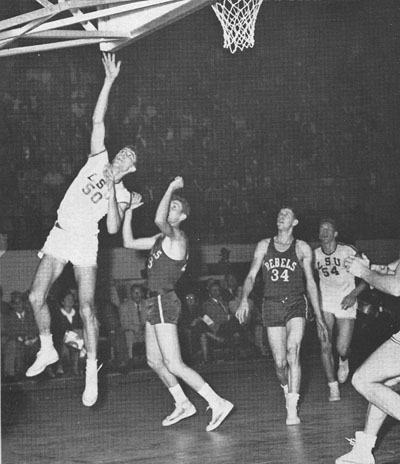
Pettit in action vs Ole Miss
Kentucky returned to SEC action Pettit's senior year.
- However, the Tigers and Wildcats didn't meet in the regular season as both went undefeated. Bob outdid himself, averaging 31.4 ppg, which would have led the nation most years. But Furman's Frank Selvy set the collegiate record with 41.7 ppg.
- So the two SEC powerhouses met in a playoff at Nashville to determine the conference representative in the NCAA Tournament. Bob would meet up with his nemesis, Cliff Hagan, who had alternated with him breaking the conference single game scoring record. Pettit broke the record with 50 points only to see Cliff can 52 later in the season. But three night later, Bob scored 60 against Louisiana College to regain the top spot. Neither knew at the time that they would be teammates for many years on the St. Louis Hawks.
- The #1 Wildcats prevailed 63-56 in one of the finest games I was ever in (Pettit) to run their record to 25-0. However, Coach Adolph Rupp chose not to participate in the tournament because the NCAA ruled Frank Ramsey, Cliff Hagan, and Lou Tsioropoulis ineligible because they had already graduated.
So the Tigers headed to the NCAA Tournament for the second straight season.
- With basically the same team as the year before, LSU went to the regionals at Iowa City.
- They met up with Penn State, which deployed a pressing zone defense that rattled the Tigers, who fell 78-70.
- LSU faced Indiana again in the regional Consolation Game and fell to the Hoosiers 73-62.
Pettit was selected to play in several All-Star games around the country.
- He played on the West team that beat the East in Kansas City and earned the MVP award.
- Then he played in New York on the East team that may have been the greatest college All-Star team ever assembled. The guards were Selvy and Ramsey with Palazzi and Hagan the forwards and Bob in the middle. Richie Guerin and Larry Costello came off the bench. But the West upset the East thanks to "that man" Bob Leonard, who netted 21 and took home the MVP trophy.
1954 East All Stars
 21 Frank Ramsey, 23 Frank Selvy, 29 Lou Tsioropoulos, 28 Togo Palazzi 21 Frank Ramsey, 23 Frank Selvy, 29 Lou Tsioropoulos, 28 Togo Palazzi
Standing: Larry Costello behind Pettit, Richie Guerin second-from-right, 21 Cliff Hagan
Bob now prepared for the NBA draft.
Continued below …
Reference: Bob Pettit: The Drive within Me, Bob Pettit with Bob Wolf (1966)
Top of Page
Profile: Bob Pettit - III
With the second pick in the 1954 NBA draft, the Milwaukee Hawks chose Bob Pettit.
- Uncertain whether he wanted to turn professional, Bob turned down an invitation to tour the country playing against the Harlem Globetrotters.
- He had received a few good offers from top amateur teams like the Phillips Oilers and the Peoria Caterpillars. You worked for the company that owned the team that you played for.
- Bob wanted to maintain some leverage in negotiating with Ben Kerner, the Hawks' owner. Pettit called his cousin, Frank Brian, an LSU basketball star who had played pro ball for Kerner and praised Ben for his honesty.
- In the meantime, he returned to LSU to finish his degree in Business Administration.
- Deciding that playing in the NBA gave him an off-season whereas working for a company he played for was a 12-month commitment, Bob agreed to an $11,000 contract - the most ever paid a rookie.
- Years later, Kerner recalled: I knew that Pettit was a top college player and everyone had heard of him, but never in my wildest dreams did I think he'd have such a great career.
When Bob moved to Milwaukee, he quickly realized that basketball was a distant second to baseball there since the Boston Braves had just moved there in 1953.
- Bob knew another former Tiger, Joe Adcock, who played 1B for the Braves. Pettit sublet Joe's apartment when the baseball season ended.
- The Hawks' coach was Red Holzman, who would attain fame as coach of the New York Knicks' championship teams of 1970 and '73.
- Red immediately moved the 6'9 205 lb Pettit to F, a move for which Bob has been eternally grateful.
As a forward, I had to learn the game of basketball all over. Very little of what I knew then was applicable in the pros because in the past I played with my back to the basket and only about 12 feet from the hoop. Now I was facing the basket and was 18 feet away and I had none of the moves which are a must for a forward.
Now more than ever, I had to rely on my jump shot and it was a lucky thing I had spent so much time perfecting it. Although I did not use it to any great extent in college, the jump shot soon became my most frequent weapon in the pros. ...
At first, driving was my biggest problem in the pros because I neglected dribbling as part of my game. ... Now I had to learn to drive around my man, which required a good deal of dribbling. I worked hard at it, but all through my career, I never could master the dribbling art.
- Pettit also had to learn to move without the ball on offense and play defense on a forward.
- Kerner visited training camp to get a firsthand report on the team and particularly his #1 draft choice. Holzman told his boss that Pettit could shoot, but his defense was horrible, and his rebounding was worse!
- Continuing the work habits that earned a gangly, uncoordinated kid a spot on his high school team and helped him become a college All-American, Bob turned himself into one of the best rebounders in the history of the NBA, averaging 17 to 20 rebounds a game his last five seasons in the league.
- The exhibition season quickly convinced Bob, if he didn't know it already, that pro basketball was much more physical than the college variety. Fortunately, the weight training program he had started in Baton Rouge with Alvin Roy helped him gain weight and strength to withstand the rigors of the 82-game NBA schedule.
|
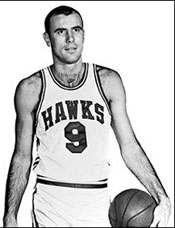
Bob Pettit

Ben Kerner
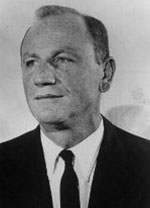
Red Holzman
|
Midway through his rookie season, Pettit began to play good ball.
I was gaining confidence and hitting my jump shot and my hook shot and I was even starting to score points on a drive and rebounding off both boards. I went through one stretch in which I scored 30 or more points seven consecutive nights. I was even getting accustomed to the rough stuff and not minding it very much anymore.
- Kerner scheduled three "home" games in New Orleans, Shreveport, and Baton Rouge on consecutive nights in January.
- The Louisiana capital city staged Bob Pettit night, and their hero scored 21 points to delight the 12,000 in attendance, although the Minneapolis Lakers beat the Hawks 100-92.
- Bob was one of two rookies selected to play in the All-Star game in New York. After averaging 20.4 ppg, he was chosen Rookie of the Year and the All-Pro team, only the second time a first-year player had been chosen for that honor.
- It wasn't enough to keep the Hawks out of last place in the Western Conference with a 26-46 record.
- Kerner lost an estimated $40,000 that year on top of the debt he already owed. As Bob says, He knew he had to get out of Milwaukee because the people there just didn't give a hang about basketball.
- So in August Kerner moved his Hawks to St. Louis.
Continued below …
References: Bob Pettit: The Drive within Me, Bob Pettit with Bob Wolf (1966)
Tall Tales: The Glory Years of the NBA, in the Words of the Men Who Played,
Coached, and Built Pro Basketball, Terry Pluto (1992)
Top of Page

Bob Pettit in action
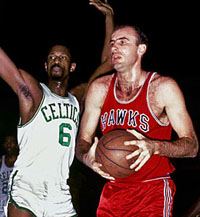
Pettit and Bill Russell
|
Bob Pettit's second year in the NBA coincided with the Hawks' first year in St. Louis.
A major trade helped the Hawks improve in 1957.
- St. Louis gave the 2nd pick in the draft to Boston and received Ed Macauley and Cliff Hagan in return. The Celtics used the pick to take Bill Russell. Pettit recalled: I had pretty good success against him, then Red Auerbach made him take the pivot man and he first used Tom Heinsohn, then Jim Loscutoff and finally Tom Sanders to guard me and this is when I began having trouble with Russell. If I would get by Heinsohn or Sanders or Lusky along would come Russell to stop me. What made it difficult was that I never knew where Russell was coming from.
- Pettit again led the NBA in FGA and FG but not in scoring or rebounding.
- The 41-31 Hawks made it all the way to the finals, losing to the Celtics in seven games.
- Concerned because he was getting pushed around under the basket, Pettit returned to Baton Rouge and worked with Alvin Roy, who was the Olympic weight lifting trainer at Helsinki in 1956.
The Hawks not only made the finals again in 1958, they won the championship.
- Pettit suffered his second broken wrist in as many seasons, the injury costing him the rebounding and scoring titles.
- In the repeat finals against the Celtics, St. Louis led three games to two going into Game 6 at home. Bob scored 50 points, including 19 out of the Hawks' last 21, to edge Boston 120-119.
- Pettit wrote in his autobiography: To this day, Auerbach still needles [Tom] Heinsohn that the Celtics would have won the championship that year too if Tommy had held me to 48 points.
|
St. Louis and Boston again won their divisions in 1959.
- Bob's 29.2 ppg broke the all-time average per game scoring record of 28.5, which had been held by George Mikan.
- The third straight Hawks-Celtics final was derailed by the Minneapolis Lakers who, led by rookie F Elgin Baylor, upset St. Louis in six games in the Western Finals to earn the privilege of losing to Boston in the finals.
Aided by the acquisition of burly C Clyde Lovellette, the Hawks again won the West in 1960.
- They got revenge on the Lakers in the Western finals in seven games.
- That set up the third St. Louis-Boston championship series in four years.
- Once again they staged a classic, the Celtics winning in seven games.
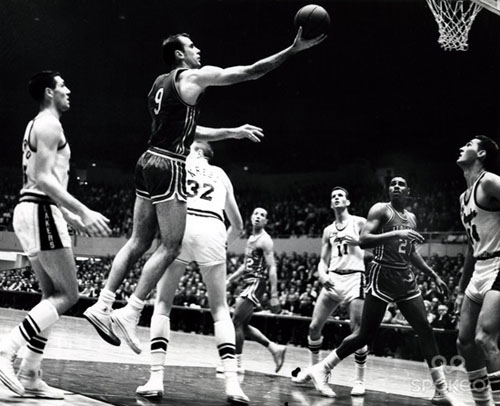
Notice Jerry West under the basket.
The new acquisition for 1961 was G Lenny Wilkins.
- The Hawks won the Western Divison by 15 games over the Los Angeles Lakers but had to go seven games to get by those same Lakers in the conference finals.
- That set up still another confrontation with the Celtics, who again had home court advantage by virtue of a better regular season record.
- Boston needed only five games to dispath the Hawks this time.
Boston entered the service the next year, with devastating results for the Boston.
- They suffered through their worst season in the Mound City: 29-51 and no playoffs for the first time in seven years. The Hawks had the dubious distinction of being the first NBA team to follow a 50-win year with a 50-loss season.
- Ironically, it was the only season that Pettit averaged over 30 points a game: 31.1 ppg and 18.7 rpg.
The Hawks lost in the Western finals in each of Bob's remaining three seasons before retirement at age 32 after the '64-65 campaign.
- His scoring average dropped from 28.4 to 27.4 and finally 22.5.
- He left the NBA with a career average of 26.4 ppg and 16.2 boards per game.
- The was voted into the Hall of Fame in 1971.
Reference: Bob Pettit: The Drive within Me, Bob Pettit with Bob Wolf (1966)
Top of Page
The date was Saturday, February 21, 1970.
- Pete Maravich played his final home game of his illustrious career at LSU.
- The opponent was none other than the Kentucky Wildcats, the #2 team in the AP poll.
- The result was one of the most amazing games ever played in Baton Rouge - or anywhere else, for that matter.
- It isn't often than a player scores 51 points in a game and isn't the leading scorer - and by 13 no less.
- Another astonishing fact: The teams combined for 226 points, but the game was never tied.

Adolph Rupp
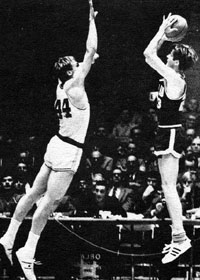
Pete Maravich shoots over Dan Issel in the January 24, 1970, game in Lexington.
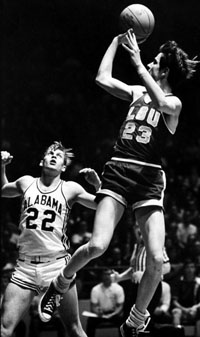
Pete shoots during his 69-point effort against Alabama.
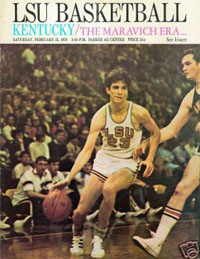

Bill Newton

Mike Pratt
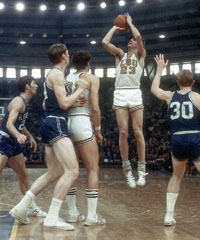
Maravich shoots behind Apple Sanders' screen.
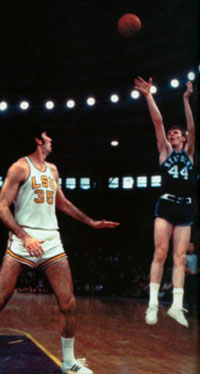
Issel launches over Danny Hester.

Press Maravich
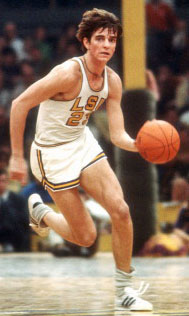
Maravich moves against UK.
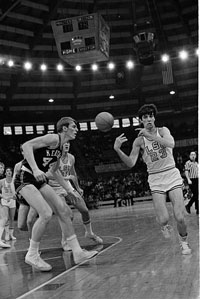
Pete tosses a no-look pass.
|
Pete's counterpart with the Wildcats was senior C Dan Issel.
- Dan averaged 25 points and 18 rebounds as a high school senior in Batavia IL. More than a hundred colleges offered him a scholarship. When he chose Kentucky, coach Adolph Rupp called Dan "the best center prospect we've had here in some time. He's a big, strong boy and he moves well."
- Rupp's longtime assistant Harry Lancaster agreed. "He's big enough, strong, fast, and quick. He's also aggressive, highly intelligent, and very mature for his age ..."
- From the word go, Dan made no secret of the fact that he wanted to be an All-American and play pro ball. He accomplished both goals.
- Like Pete, Dan had become his school's all-time leading scorer. He came into the game averaging 32.2 ppg and 13.1 rbg in 1969-70.
- 6'6" sophomore Al "Apple" Sanders from Baton Rouge High, who was battling Georgia's Bob Lienhard for the SEC rebounding crown, would join fellow front court members Bill "Fig" Newton and Danny Hester in trying to stifle Issel.
More than 9,000 were expected at the John F. Parker Agricultural Coliseum, popularly known as "The Cow Palace."
- The 17-6 Tigers needed to win to stay in the SEC race, where they sported a 10-3 mark. They also hoped for an NIT bid to give Pete a chance to showcase his skills in the Big Apple. An upset of the 20-1 Wildcats would practically cement a bid.
- Kentucky beat LSU in Lexington in January 109-96 despite Maravich canning 55.
- The Wildcats held an incredible 31-1 edge over the Tigers alltime. The lone LSU victory came in 1961 in Baton Rouge 73-59.
The game would be televised nationally.
- Eddie Einhorn's Television Sports Network specialized in airing regional games and held the TV rights for SEC basketball.
- Einhorn started showing SEC games regionally in 1965, and sometimes the crowds were so sparse that he asked fans to move to one side of the gym so the camera could see them.
- But Pistol Pete had changed all that, drawing capacity crowds all over the league and generating buzz across the land with his 44ppg average. His 3,365 points had already set an all-time record.
- Two weeks earlier, TSN had shown LSU's game at Alabama. Pete scored 69, which would prove to be the high of his career, but the Tigers fell 106-104.
- With Kentucky the opponent, Einhorn decided to market the Cat Clash in Baton Rouge nationally. He signed up 206 stations, more than carried the famous UCLA-Houston game from the Astrodome two years earlier. Eddie also set the game at the more attractive 3:30 PM ET slot following regional contests earlier in the day.
LSU students camped out all night Friday into Saturday to assure themselves of seats.
- Many tried to hide out in the Coliseum over night, but police made a wee hours sweep. Some took refuge in the bathrooms, standing on toilets to evade detection. By daybreak, the arena was cleared.
- When the gates opened at 11:30, students, many with pillows and sleeping bags in tow, were admitted. When Pete first appeared at 1:49, he received a standing ovation.
- Numerous fans brought homemade signs. "Thanks for coming to LSU, Pete." "Pete for Governor - Bordelonville fans." "Pete for President."
- In the freshman game that opened the doubleheader, the Kentucky Kittens nipped the Baby Bengals 78-77. Gary Simpson of LSU led all scorers with 35 points.
Four Bengals joined Pete in making their final appearance at home - three other starters plus backup G Rich Hickman.
Starting Lineups
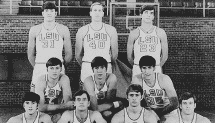
1969-70 LSU Tigers |
LSU |
|
Kentucky |
| Bill Newton |
F |
6-9 |
Sr. |
|
Mike Pratt |
F |
6-4 |
Sr. |
| Danny Hester |
F |
6-8 |
Sr. |
|
Tom Parker |
F |
6-6 |
So. |
| Al Sanders |
C |
6-6 |
So. |
|
Dan Issel |
C |
6-8 |
Sr. |
| Pete Maravich |
G |
6-5 |
Sr. |
|
Terry Mills |
G |
5-10 |
Sr. |
| Jeff Tribbett |
G |
6-0 |
Sr. |
|
Jim Dinwiddie |
G |
6-4 |
Jr. |
Watch the video of the game, and you get some immediate impressions.
- First, you see only white players on both sides.
- Second, there are only two officials.
- The style of play, with both teams topping the century mark, approximates the NBA of its time rather than the college game of that era. I say the NBA "of its time" because today's play in both pro and college ball is much more physical. A big reason teams in 1970 generally scored more points is that defenders were hardly allowed to touch players, especially those going for a shot.
- Not even the NBA 24-second shot clock was needed. Neither team rarely exceeded 15 seconds in a possession.
- The idea for Kentucky was to pass the ball quickly until you either found Issel in the post or someone moving into position for an open jump shot.
- LSU, of course, put the ball in Pete's hands and let him work for a shot or draw defenders to himself and pass to the open man.
- Pete could be forgiven for relaxing on defense, but occasionally he struck like a cobra, his quick hands deflecting a pass or knocking the ball out of the hands of the opponent.
- Issel doesn't catch your eye right away like Pete but has to be watched over the duration of the game to appreciate him. He works for position inside, gets putbacks, gets fouled often and sinks the FTs. Not flashy like Pete but very effective.
- Bottom line: Issel had much more scoring help from his teammates than Pete got from his.
The two other players in the LSU Basketball Trinity, Sparky Wade and Bob Pettit, sat among the crowd of 9,000, which didn't quite fill every seat.
- A three-point play by UK's second-leading scorer, Mike Pratt, and an Issel tip-in staked the Wildcats to a 5-0 lead. The Tigers spent the rest of the game trying to catch the Cats but never succeeded.
- When Pete missed his first try, a layup, he complained of being hacked. He would shoot 17 FTs, making 13, before the day was over. Pete and his father-coach both thought he should have shot more freebies.
- In the early going, it was Pratt, not Issel, who kept up with The Pistol. By the first timeout at 14:32, Mike had seven points and Pete, three buckets.
- With UK on top 17-10, LSU launched a serious run at the lead and, for the first time, got the Wildcats slightly rattled. After the Tigers pulled to within 21-18, Issel made two FTs, but Maravich and Newton scored baskets to close the gap to 23-22. Issel again prevented the Bengals from tacking the lead when he hit a jumper from the corner.
- A few minutes later, with the score 32-28, Kentucky put six in a row on the board for a 10-point advantage.
- In the meantime, men in blue were getting into foul trouble trying to stop Pete. Dinwiddie has two and his replacement, Kent Hollenbeck, quickly collected three. So Mills took a turn at 4:01 with the scoreboard reading 45-40.
- But the Tigers could get only a point closer before a 6-2 sent the Big Blue into halftime with a 56-48 advantage.
- Maravich led Issel 31-18 in their personal battle. They would both score 33 in the second 20 minutes of action. What hurt LSU was that Pratt tallied 19 in the first 20 minutes.
LSU conducted a special ceremony at halftime.
- The school retired Pete's #23, which also happened to be Sparky Wade's number. Maravich became only the third Tiger athlete whose jersey was retired, joining Bob Pettit and Billy Cannon.
- The Pistol and his three fellow seniors were presented with life-size action photographs of themselves.
The second half started at the same pace.
- The Wildcats upped their lead to 10 several times, the second time at 74-64. At that point, Press called timeout.
- Whatever the elder Maravich told them worked as Pistol Pete and Hester ripped off eight straight between them to pull LSU within two, 74-72, with 11:16 on the clock. That provoked Rupp to call time and switch to a 1-3-1 zone with a trap on Pete.
- When play resumed, Issel and Maravich traded baskets. After another UK two-pointer, Hester made a basket in close off a feed from Pete. Then the same pattern made it 80-78 when Hickman connected from the side at the 9:17 point.
- Finally, the trap defense forced several turnovers to contribute to ten straight Big Blue points. First, Mills dropped in a 20' jump shot. Soon after, Pete tried to pass inside, but UK intercepted, which led to Mills scoring on a fastbreak layup. With 8:01 left, Dinwiddie fouled Pete as he drove to the basket. But after making his first 14 FTs, the Pistol missed both shots. That led to the first of two straight three-point plays by Issel. Just like that, the visitors had extended their lead to 90-78 with 7:36 remaining.
- To make matters worse for the home team, Sanders and Newton both picked up their fourth fouls. Fig soon fouled out and, after that, there was no stopping Issel. The Tigers could get no closer than 10 the rest of the way.
- Several times fans threw ice and paper cups on the floor to protest officials' calls or non-calls.
- With one second left, Pete canned a jumper to finish with 64 points, the most he had ever scored in the Cow Palace, and make the final 121-105.
- Several deputies escorted the refs off the court.
- The two stars ended with these stats:
Player FGM-A, FTM-A,Reb,TP
Maravich 23-42, 18-22, 4, 64
Issel 19-33, 13-1 7, 17, 3, 51
- The Wildcats hit a sizzling 57.3% from the floor. The Tiger Cats did well themselves - 53.2%. Kentucky, beaten on the boards in the earlier matchup in Lexington, won the rebounding battle this time, 51-44.
- Issel got more help from his mates than Pete: Pratt 27, Parker 18, and Mills 14. On the LSU side, Hester threw in 17 and Sanders 11 (with 15 rebounds), but no one else scored in double figures.
Postgame
- Press Maravich: The little things beat us. They've beaten me for four damn years against Kentucky. We shot with them. We rebounded with them. But the ball was always squirting out of our hands, bouncing off our fingertips. And they'd just pick it up and put it in the basket. ... I really thought we could win it when we got real close there in the second half. I thought we'd recover and go over the hump when we were down by two, but Terry Mills killed us with two straight baskets. Press wasn't happy with the officials, saying that an official could take away a team's momentum with a poor call. Concerning the two-minute period when Kentucky scored ten straight after LSU pulled to within 80-78, Press said, I think that if we had tied them, then we would have beaten them. I'm sure of it. We would have had the momentum. It would have turned the game around.
- Rupp: It was just a question of two All-Americas going out there and proving they were All-Americas. I thought we had a more balanced attack with Dan Issel, Mike Pratt, and Tom Parker than they had with Pete Maravich and Danny Hester. Hester was really the only other LSU player to give us any real trouble in scoring although the Sanders boy got up on those boards. I wasn't pleased with our organization out there today, but how do you get organized against a Pete Maravich? ... There's really no effective way of organizing a defense to stop him. You give him an alley, and he's to the basket before you know it. You keep him outside, and he picks off the baskets with ease. There's one consolation, however, if you can call it that. He's played against us six times and hasn't beaten us once. That's true of the big LSU All-America Pettit, too. Pettit got a lot of points, but he never beat us. ... When you get down to it, the game wasn't really full of strategy. We knew Maravich would give us trouble; they knew Issel would give them trouble. Our guards committed 12 fouls trying to guard Pete, but who doesn't foul when he guards or tries to guard Pete? ... If both Maravich and Issel don't make All-America again, something's wrong with the selectors.
- Pete delayed as long as possible before speaking to the media. What happened? he said, repeating the reporter's question. Well, for one thing, Kentucky was hot as hell. And for another, it seemed every time I looked up, one of their guards would lose the ball. It would roll through nine pairs of legs and Issel would stick it in for a three-point play. ... Kentucky would still have won the title, even if we had beaten them. But I think it would have been good for the conference if we had beaten them. And it would have given us something to bring into the NIT. That's what we're looking forward to.
Asked about his play, Pete replied: No, I really am not completely satisfied. I missed too many easy shots. But I did think I played better defense than I did up at Lexington. We were trying to put more pressure on their guards than we did up there, and it will show up in their turnovers.
Dick Fenlon wrote in the Louisville Courier-Journal the next day:
Pete has never played in Madison Square Garden, site of the National Invitational Tournament. But, with a 17-7 record, LSU will certainly be invited this year, even if it loses its four remaining games. The Pistol is too much of an attraction for the promoters to pass up. LSU won three of its final four games, all on the road, and received the NIT invite.
Since LSU had played UCLA earlier in the season (a 133-84 loss in December), writers asked the Tigers to compare the top two teams in the nation.
- Pete Maravich: Kentucky, like UCLA, is a true champion. I really can't say who would win if they place in the NCAA. It will be close.
- Sanders had a different view. UCLA would win it. They haven't got anybody like Issel, but they've got a better overall ball club.
- The Wildcats would not meet the Bruins during March Madness. Kentucky lost to Jacksonville and C Artis Gilmore 106-100 in the Mideast Regional Final. The Dolphins then lost to UCLA in the finals.
References: Echoes of Kentucky Basketball: The Greatest Stories Ever Told,
Scott Striklin (ed.) (2006)
Pistol: The Life of Pete Maravich, Mark Kriegel (2007)
Top of Page
|
Dale Brown's 1987-88 Tigers began the season 2-0.
- LSU captured its own invitational tournament with victories over Nicholls State 86-62 and Southern 75-59.
- Now the Tigers would step up in class as they hosted the Maryland Terrapins in a Saturday afternoon clash that would be televised on ABC-TV.
- The Terps of second-year coach Bob Wade came in 5-1, including a win over Ole Miss 77-69. The loss came at the hands of West Virginia 74-45.
- The Tigers would have to contend with 6'10" freshman C Brian Williams, termed "the player who should have the biggest impact of the freshmen to a program" by Street and Smith's Basketball Magazine, which rated the Terrapins' recruiting class #8.
- Brown sent this starting lineup out for the opening tap:
F Ricky Blanton 6'7"
junior
F
Bernard Woodside 6'6" junior
C Jose Vargas 6'10" senior
G Fess Irvin 6'1"sophomore
G Darryl Joe 6'1"
senior
The last time LSU appeared on TV was March 22, 1987.
- The Tigers lost to Indiana 77-76 in the Elite Eight round of the NCAA Tournament in Cincinnati.
- With 26 seconds left, LSU led 76-75. Freshman G Fess Irvin, a Parade All-American from Gonzales LA, stepped to the FT line to shoot one-and-one. He had sparked the Tigers off the bench with 14 points and three assists in 22 minutes. He had made six of seven from the floor, including two of three from 3-point range.
- Fess said afterward: I went to the line with a lot of confidence. I pictured myself making the shot. But I made a mistake. When I released the ball, I started back off the line to get to the defensive end.
- Indiana grabbed the rebound and turned an airball into a basket with seven seconds left to claim the victory.
- Coach Brown after the game: He missed that free throw, but it will make him a better player and a better person because of it. I know he's heartbroken now, but he'll get over it. This is just one game. There will be others for Fess Irvin. He's playing with a lot of confidence right now. He's going to have other opportunities to win important games before he leaves LSU, believe me.
- Fess: I want to take two weeks off, then begin preparing for next year. That free throw didn't fall, but I just have to forget about it and make something positive happen from this negative.
A crowd of 10,222 and the regional TV audience saw an exciting game that went down to the last second.
- LSU started cold, one-of-seven from the field. After trailing briefly, Maryland took control behind the inside scoring of Williams and Derrick Lewis. They led by as many as 11 points in the first half. With 6:49 left in the first half, the Tigers were just 4-of-16 but had pulled to within three, 18-15, thanks to excellent defense.
- Trailing 36-28 with 15:28 to play, LSU went to a 2-3 matchup zone. Maryland missed its next five FG attempts, allowing the Tigers to tie the game at 36 on a steal and basket by Darryl Joe. Maryland edge back in front 42-38 with eight minutes left.
- When Brown went back to man-to-man at that point, the Terps responded by making their next seven shots. But three turnovers down the stretch allowed LSU to take the lead for the first time since early in the game. Vargas did it emphatically with a slam to make it 51-50 with 2:13 on the clock.
- The lead didn't last long. A three-pointer and a FT put the visitors back in front 54-51 with just over a minute remaining. Maryland grabbed Irvin's miss to get a chance to at least run some clock. But Fess stole the ball.
- LSU called timeout with 50 seconds to go. Brown inserted freshman Kyle McKenzie and nine seconds after play resumed, he threw up a 3-point attempt that missed from 22'. But he was fouled on the play. He made two FTs to pull LSU within a point.
McKenzie: Coach Brown has always taught positive thinking. He said, "Go in there and hit it." So that's my job to hit the shot. And I just thought to myself that I would make it.
- UM inbounded and tried to run some clock, but Woodside fouled John Johnson at 0:25. He had made 8 of 11 FTs in the Terps' first six games but hadn't shot one in his two minutes on the court in this game. He missed, and Vargas cleared the rebound.
Brown: I hope my mike wasn't on the last 25 seconds or so or I might be taking over Jimmy Swaggart Bible College of something. I said, "God help us this last 25 seconds." I don't know if He heard me or not.
- With 10 ticks on the clock, Blanton missed from the baseline, and the rebound bounced long where Woodside beat the Terps to the ball. Bernard started to go to the goal from the right side but was cut off in the lane. Then he saw Irvin and shot a bullet pass out to Fess all alone just to the left of the key.
As soon as he (Irvin) got set, I knew it was going in, Brown said afterward.
Fess's 19' jumper went in with 0:02 left.
- Maryland called timeout with a second remaining, but a long inbounds pass ended up in the hands of Vargas, who cradled the ball as the Tigers and their fans celebrated the 55-54 triumph.
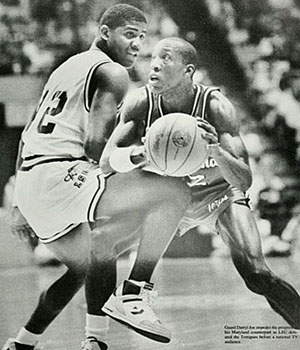
Darryl Joe vs Maryland
Vargas outdueled freshman Williams.
- Jose led all scorers with 16 points and also topped the rebounders with 10.
- Williams canned 5-of-8 for 10 points but fouled out with 5:38 left.
- The only other Bengal in double-digits was Blanton with 10.
Postgame
- Irvin on his winning basket: There wasn't any doubt when I let it go. On the 3-pointer that I missed before that, I said to myself, "I know it's going in." But I knew the next one was going in. ... The shot I missed in Cincinnati, it hurt. But it motivated me. I think you saw that today. Sometimes you make it, sometimes you miss. Last year, I thought a missed shot was the end of the world. Now, I realize it's only a game.
- Brown: It was appropriate for Fess that he hit the shot. At the end of the season (against Indiana) when Billy Packer (CBS broadcaster) left his mike on, he said, "Fess choked." Fess didn't choke. He missed a free throw. We lost a chance for a national championship.
- Wade: Today we came out with fire in our eyes. We played the entire game. We just made a few mistakes going down the stretch, but we'll just have to learn by those mistakes. I think we are maturing. The Maryland head man had coached Irvin at the Five Star Basketball Camp two years earlier and was pleased that his former pupil was the one who made the winning shot. Now that the game is over, I'm happy for him. We lost, but I'm happy any time a young man does well, even if he does well against us. But most importantly, he's a gentleman. He has class, and I've always been proud of him.
The '87-88 Tigers finished the regular season 16-13 and lost in the first round of the NCAA Tournament to Georgetown 66-63. Fess Irvin left LSU after his sophomore year and transferred to James Madison having never lived up to his Parade All-American billing.
|
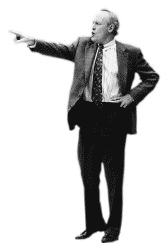
Dale Brown
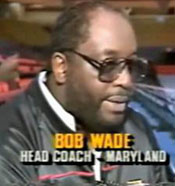
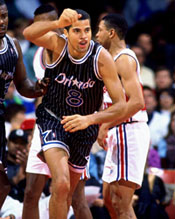
Brian Williams
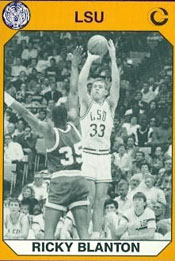

Fess Irvin
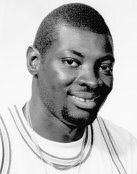
Jose Vargas
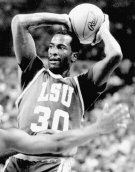
Bernard Woodside
|
|
|



















 21 Frank Ramsey, 23 Frank Selvy, 29 Lou Tsioropoulos, 28 Togo Palazzi
21 Frank Ramsey, 23 Frank Selvy, 29 Lou Tsioropoulos, 28 Togo Palazzi





















